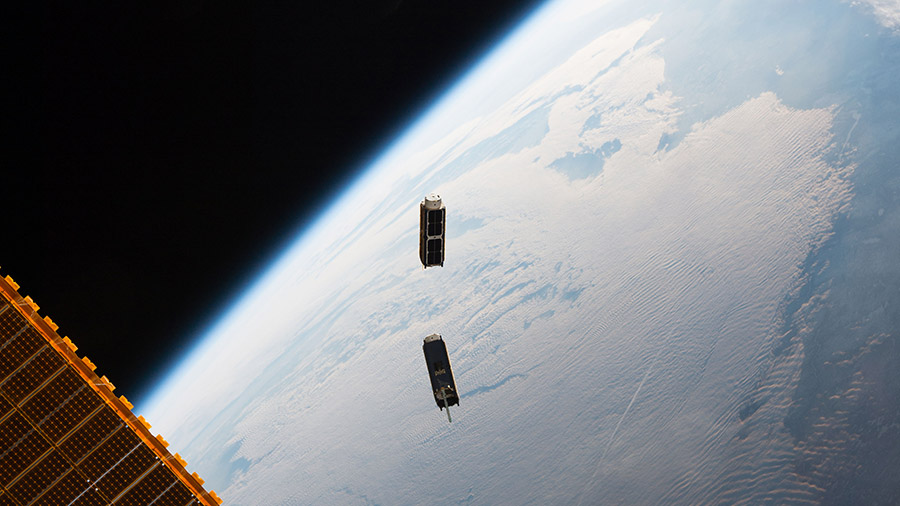 |
| Satellites Lite: two little Cubesats head out to work in the atmosphere. (Image courtesy NASA.gov.) |
Space Station Sunday: 100,000 Laps And Still Lofty
Good afternoon, space fans! It's been another stellar week in space.
Tutorial: Introduction to SpriteKit in Swift
| (Image courtesy developer.apple.com) |
Ultra-Modern Art: World's First Software-Generated Art Competition Produces Striking Results
Yesterday we talked about how robots are coming for your menial-labor jobs. But what about artistry? Surely, even with robot poets, robot "dreams", and robot literary aids, there's no way that a computer could become autonomous enough to actually paint something that we'd recognize, right?
Wrong, puny human. They can out-art us, too.
Wrong, puny human. They can out-art us, too.
| Could a robo-Banksy be tagging the cities of the future? Or will they be more refined, such as a Van Gogh-bot? (Artwork by Banksy. Image courtesy businessinsider.com.) |
Would You Like Microchips With That? Wendy's Unveils Touch-Screen Ordering At Many Locations
Well, it's been at least a week since our last robot report, detailing which jobs are now going to be outsourced to non-humans. Clearly manufacturing was headed this way since mechanization proved how woefully weak humans are at churning out cheap goods without the need for rest of any kind, but what about the service industry?
Robot bartenders may not be able to talk about your problems, robot hoteliers may not be able to score you the best drugs on the DL...will robot fast-food workers really improve things so humans can "have it our way"?
Robot bartenders may not be able to talk about your problems, robot hoteliers may not be able to score you the best drugs on the DL...will robot fast-food workers really improve things so humans can "have it our way"?
| Fast, good, cheap...pick two. Guess which ones Wendy's owners are going with? (Image courtesy vocativ.com.) |
Get The Word Out: New In-Ear Device Translates Foreign Languages In Real-Time
Have you ever dreamed of traveling the world, conversing freely with the people you meet, exchanging stories and experiences despite your myriad differences in language and location? Or have you at least dreamed of hollering down the bar at that foreign hottie in their native language and obtaining more than a baffled look (and possibly a slap) in return?
If so, a new bit of technology just became your international wingman.
If so, a new bit of technology just became your international wingman.
| Pictured: the world's first commercial in-ear translator, the app that helps choose languages, and the mademoiselle that now can't pretend she doesn't understand you. (Image courtesy la-kabylie.com.) |
Space Station Sunday: My God, It's Full Of Science
Roses Are Red, Deathscreens Are Blue, A Computer Writes Poetry...Better Than You?
Humans have been writing poetry since we could figure out how to rhyme our grunts. Now, computer AI programs want in on the action. But are they any better than, say, your average disturbed goth teenager?
| They want to touch us with their verse. And soon, their metal claws and enslavement software. (Image courtesy abc.net.au.) |
Indiana Drones? Canadian Teen Uses Satellite Imagery And Google Earth To Spot Possible Lost Mayan City
One of the greatest elements of modern technology is how it can inform us not just about the present (and possibly, via accrued data, the future), but also teach us more about our past. Despite the fact that humans of even a few generations previous would be (or currently are) astonished and maybe baffled by our modern computing capabilities, there are certain instances in which the past and the future coalesce to convincingly capture important information for the present.
And who better to discover this than a relatively-new human being?
And who better to discover this than a relatively-new human being?
| The Mayans did appreciate a good giant pyramid. Could there be another Chichen Itza lurking here, lost in the lush jungle? (Image courtesy smh.com.au.) |
A New Don: "Yuuuge"-ly Popular App Lets Players Build Trump's Wall
The race for the presidency of the United States is heating up, with vitriol, intrigue, and computer "warfare" the likes of which society has never seen. Hillary Clinton has spent millions trying to convince shills to talk her up online and detract from her opponents (all while playing ignorant to a swath of computer crimes), while Bernie Sanders has crowdfunded a surprisingly vibrant support network via his online followers.
However, it is the nimbly adaptable Donald Trump who has used modern technology to encompass a uniquely strong spectrum, beginning with developing an oddly-enthusiastic contingent of "alt-right" supporters who create memes and catchphrases to exult the admittedly-engaging rhetoric of "Make America Great Again."
And now, as any good leader of the future would have, there is an app that supports his vision.
However, it is the nimbly adaptable Donald Trump who has used modern technology to encompass a uniquely strong spectrum, beginning with developing an oddly-enthusiastic contingent of "alt-right" supporters who create memes and catchphrases to exult the admittedly-engaging rhetoric of "Make America Great Again."
And now, as any good leader of the future would have, there is an app that supports his vision.
 |
| Could this be the ticket to resolving decades of lax leadership? Or is an app just the start of more political games? (Image courtesy twitter.com.) |
Space Station Sunday: Science And Sending Home A Dragon
Skin And Drones: Could Unmanned Aerial Vehicles Deliver Organs To Those In Dire Need?
Technology is often at its most fascinating (and effective) in the most remote regions, be it space, the deep sea, or the far-flung areas still mostly untouched by human civilization. We say "mostly", because people still live in these outbacks and backwoods, and those people have needs that only modern society can satisfy. To help these folks, a whole new usage of technology can be tested...
| Special delivery! Handle all hearts with care... (Image courtesy roboticstomorrow.com.) |
New Parts, New Art: Google's "Tilt Brush" Enables Creativity In Virtual 3D
Getting immersed in art is one of the finer pleasures of having a fully-developed human brain. Now, you can saturate yourself with many styles of painting, doodling, sculpting, and viewing artwork in glorious 3D, thanks to a new artistic software tool from Google...
 |
| From sketches to sculpture, the art world is in for a new awakening... (Image courtesy virtualartsessions.chromeexperiments.com.) |
Strained Brains And Song Refrains: Could This New Music App Help Restore Some Lucidity To Those Afflicted With Declining Minds?
Music has been inextricably linked to culture, community, and comradeship since the first caveman hit some rocks together in a catchy beat. Its influence has spanned the globe and has even journeyed into the stars. Our greatest composers and artists are held in the same respectful strata as our greatest heroes...and now, there might be one more reason why.
| Rock out 'til the clock's out. (Image courtesy kindakind.com.) |
Space Station Sunday: Satellites, Strides, And The Silver Screen
Subscribe to:
Posts (Atom)



